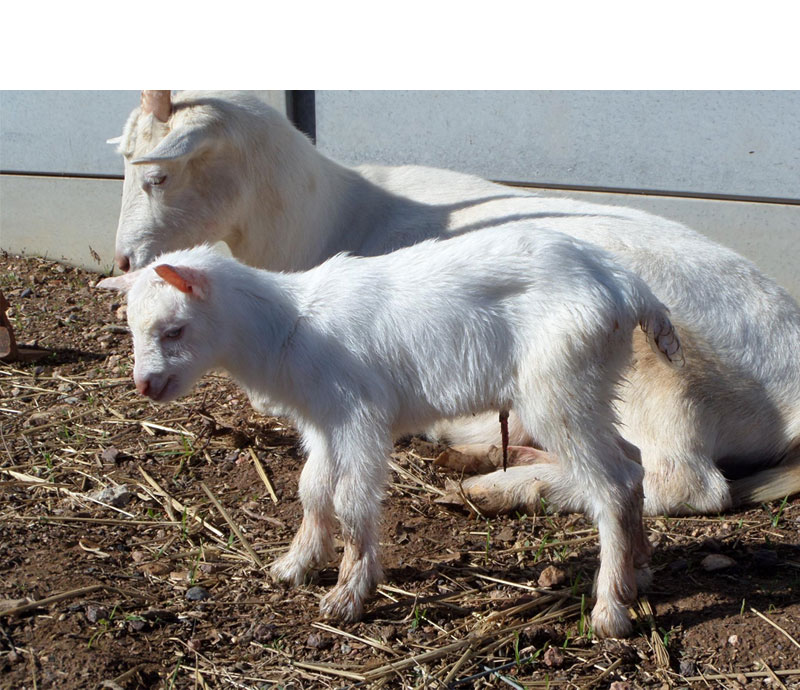


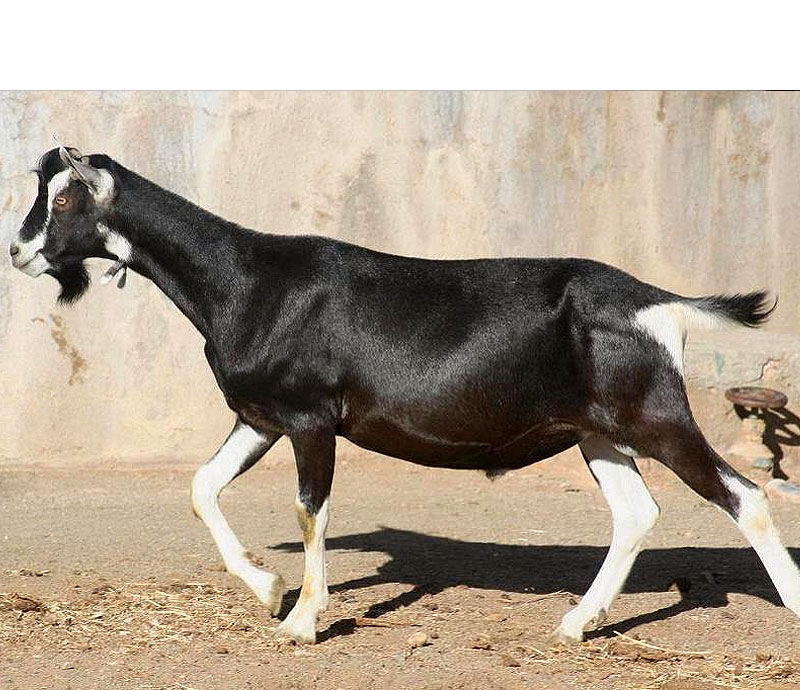
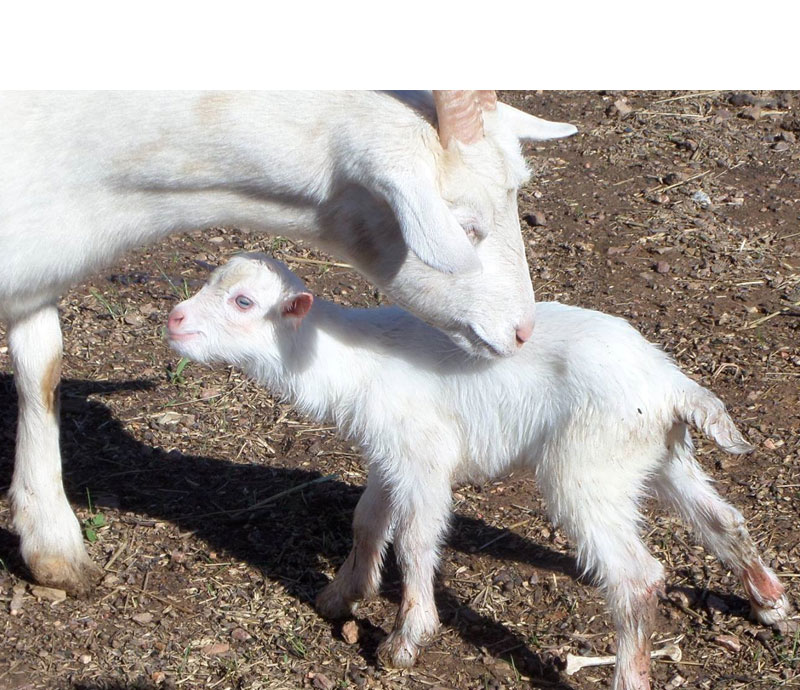
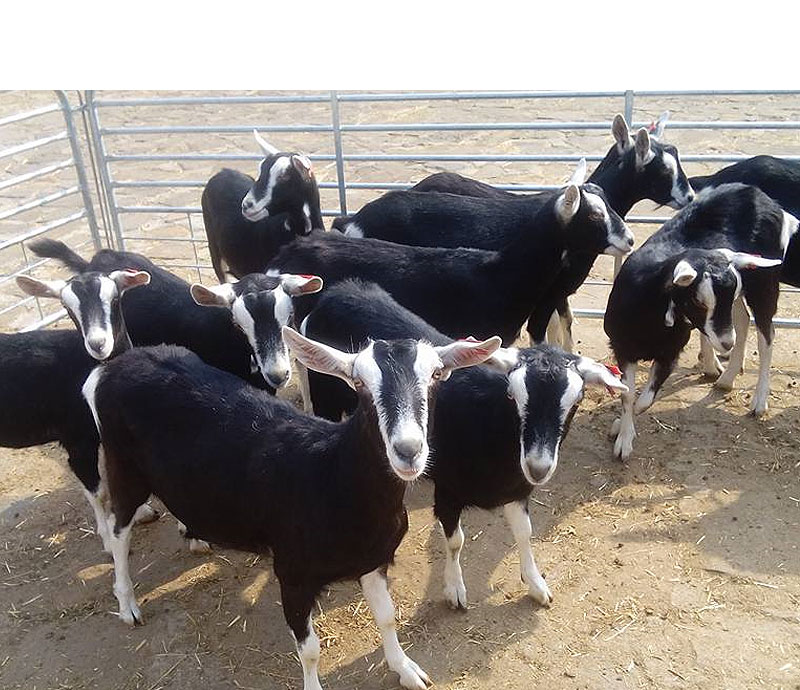
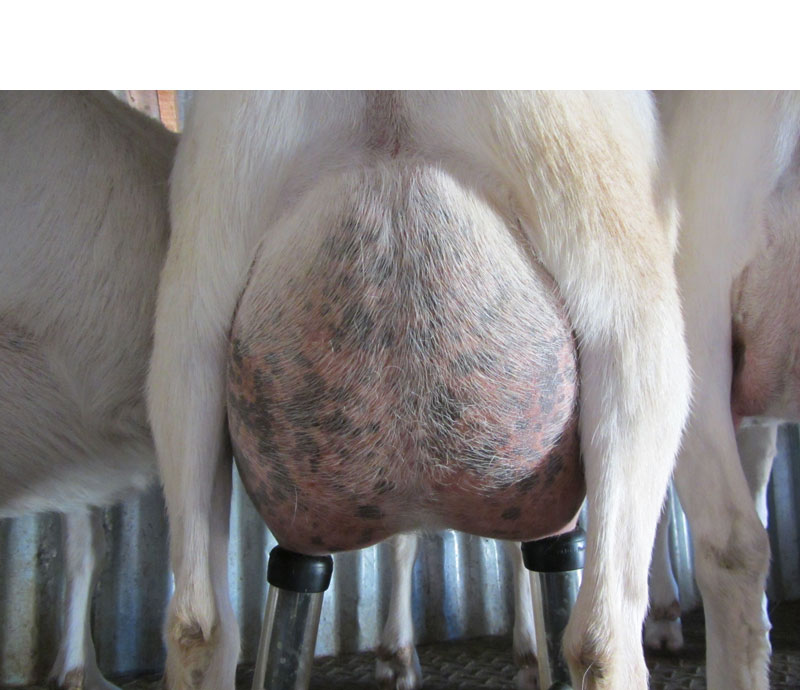
The goat’s stomach has four chambers: 1) the rumen (4-10Litre) in size. 2) the honey-combed reticulum, 3) the omasum, and 4) the abomasum or true stomach. The size relationship of the four chambers changes as the animal grows up. The abomasum gets proportionally smaller. To understand why this happens, let’s consider the function of each compartment and then review the goat’s diet.
1) The rumen acts as a big anaerobic fermentation vat. Bacteria and protozoa in the rumen supply enzymes to break down the fibre in the goat’s feed. This is similar to how bacteria can ferment the sugars in grape juice to make wine in big wine barrels. The tiny organisms in the rumen also help to build proteins from the feed and manufacture all of the B vitamins needed by the goat. Many nutrients that help provide the goat with energy are also absorbed here. The fermentation process produces heat that helps to keep the goat warm. The normal pH of rumen is 6.2-6.5.
When the adult goat eats roughage, it is chewed on, soaked with saliva (6-10L/day), and then swallowed. It goes down into the rumen to be attacked and broken down or digested by the microorganisms. At regular intervals the cud is brought back up to the goat’s mouth to be chewed on some more and then swallowed again. This entire process is called rumination. If you watch the goat’s neck carefully, you can see him swallow and later regurgitate his cud. The goat will often burp to get rid of the gas produced by all the fermentation going on in his rumen. You can really smell the fermentation process on his breath. If something causes the goat to stop being able to burp up the gases, the gas will build up and bloat or swell up his rumen and he may become very sick with “bloat”.
2) Once the food particles of cud become small enough, they pass to the second compartment or reticulum or honeycomb stomach. Here any foreign objects that may have been accidentally swallowed with the feed, settle out in the honeycomb structure of the reticulum’s walls. Another name for the reticulum is the “hardware stomach”.
3) The fermenting particles then pass on to the omasum also called the book/bible or leaf stomach. The omasum removes the water from them and also absorbs more nutrients called volatile fatty acids that help supply the goat with energy.
4) The particles are then forced into the abomasum or true stomach. Here, the particles are digested by the stomach acid, hydrochloric acid (H Cl) and pepsi enzymes. This form of digestion is the same as what occurs in our stomachs.
The remaining particles are then passed on to the small intestine where most of the nutrients are absorbed by the body and made available to the goat.
When a goat kid is born, its rumen, reticulum and omasum are very tiny and not useful. The goat kid depends on a liquid, milk, not roughage for its feed source. When the kid swallows milk, the milk goes directly to the abomasum through the esophageal groove. Everytime the kid swallows, a flap of skin at the entrance to the rumen folds over to form a groove that bypasses the rumen and sends the milk straight to the abomasum to be digested by stomach acid. As the kid gets older, he starts to consume roughage. The rumen becomes active and starts to enlarge. Its population of microorganisms increases. The reticulum and omasum also respond to the changes in diet by getting bigger. By the time the kid is an adult goat, roughage is his main source of food and his rumen is far larger than his abomasum.
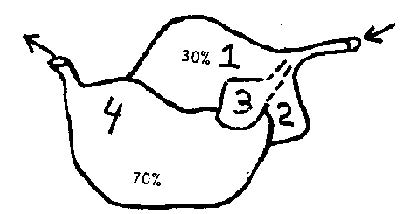
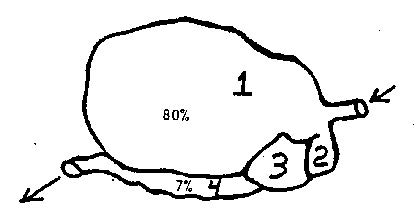
1- rumen, 2 - reticulum, 3 - omasum, 4 - abomasum
Small and large intestine
* from the abomasum, the feed enters the small intestine where nutrients are absorbed in the blood system.
* From the small intestine, the food passes into the large intestine where the water is removed and the feed is prepared for excretion.
A doe’s nutritional needs change with her stage of maturity, level of activity, whether she’s in early or late lactation or early or late pregnancy.
Similarly buck’s needs change depending if it is mating season or not. Essential nutrients are energy, protein, minerals, vitamins and water.
Dairy goats need fibre for good rumen action and normal milk fat. They should always have quality roughage in front of them. Limiting a doe’s fibre intake limits her milk yield. In natural circumstances a goat would eat 65% of its diet on its hind legs, from trees, shrubs etc. But with limited land available, and the land available does not always have shrubs or trees on it, the goats are thus forced to graze grass. What you will notice when a goat grazes is that they will eat from top down, first eating leafy weeds before eating grass. To get good sustainable milk production we need to supplement with good hay. A goat will consume 2.5-6% of body weight in dry matter daily.
One of the most important nutrients for all goats is energy – expressed as TDN (Total Digestible Nutrients)
Carbohydrates and fats together provide dietary energy, which influences growth, fertility, production, reproduction and resistance to diseases and parasites. A goat’s needs depend on stage of growth, degree of activity and weather conditions.
Protein is the primary constituent of every cell in the bodies of all animals. Protein is essential for growth, general maintenance, disease resistance, reproduction and lactation.
VIT A. is important for tissue growth and maintenance, keeps the membranes healthy, gives resistance to diseases. Vit. A keeps the membranes healthy and a deficiency can cause poor conception, abortion, eye diseases, even blindness, respiratory problems and diarrhoea.
Deficiency can cause temporary or permanent infertility in bucks. Goat’s digestive system produces Vit. A from carotene, which exists in mealies, carrots and green forage, but is deficient in old and weathered hay and grazing.
TREATMENT: Dose with oral Vit A.
VIT D. is essential for proper absorption of calcium and phosphorous. Since it is synthesized in the skin of goats, plenty of sunshine is needed.
Deficiency, can cause poor growth and feed conversion.
VIT E. is important to milk quality and reproduction. Vit. E is contained in most fresh feeds, but oxidizes rapidly so that old hay and grounded grains become poor sources. A deficiency of this vitamin disturbs both cell metabolism and the structure of all the component living parts of the cell.
The principal symptoms of the deficiency are associated with muscles, that is, the degeneration of heart and skeletal muscle. The muscle fibres become pale and hence the name white muscle disease.
Treatment: Normally the administration of Selenium, together with Vitamin E will reverse the symptoms within a week.
Prevention: The condition is unlikely to occur on pasture or grazing, and
Animals that are not grazing should be given good quality hay.
Vitamin deficiencies are difficult to detect and it’s better to act preventative. Dose A,D,E.
VIT C and K. Both these vitamins are present in grass and hay. They can also be manufactured by the bacteria in the rumen (Vit.K) or in the liver and kidneys(Vit.C) Deficiencies of these Vitamins therefore do not occur and no extra supplements need to be given.
VIT B Complex. Cerebro Cortical Necrosis, This condition, occurring in goats of any age, gives rise to nervous symptoms. This results from necrosis of cells in the cortex of the brain due to a lack of thiamine (vitaminB1)
Treatment: Inject animal with Vit B¹
Minerals such as calcium and phosphorus are essential as components of bone and teeth. They are required in large amounts, especially in the growing kid, which is rapidly building up bone and tissue growth.
Calcium.
Calcium is necessary for growth and bone development. Milk is high in Calcium so the more milk a doe gives the more Calcium she needs. Lucerne high in Calcium or can be supplemented.
Deficiency can lead to loss of milk and milk fever in does.
Phosphorus.
Calcium and Phosphorus are interrelated and should and be present in rations in the ratio of 2:1. Phosphorus is needed for tissue growth and bone development and is important for its ability to trap energy during digestion. Grains are high in Phosphorus.
Magnesium.
Magnesium influences proper functioning of the nervous system, and is related to the need for both calcium and phosphorus
Trace elements.
Some minerals are only required in minute quantities and, as only a trace is needed for healthy functioning, they are described, as “trace elements” Selenium and Copper are examples of trace elements.
Nutritional needs pre-kid
Nutritional needs of a lactating doe.
Treatment
Prevention
Symptoms
Treatment
Prevention
Symptoms
Treatment
Prevention
Symptoms
Treatment
Prevention
The internal parasites fall in three main groups: roundworms, tapeworms and flukes. Most roundworms have a direct cycle, which means they have only one host during their lifetime. After mating inside their host, female adult roundworms lay eggs which are passed out through the host’s faeces onto pastures.
A first- stage larva develops in the egg, which hatches inside the dung and feeds on bacteria. The first-stage larva moults and becomes a second – stage larva. When the second-stage becomes a third-stage larva it moves out of the dung onto grass stalks of the pasture. This is the infective stge which now waits for a suitable host to ingest it during grazing. This means that internal parasite do not multiply in the host. An increase in worm burden can only result from the intake of additional worm larvae, from contaminated pastures.
Roundworms
|
Scientific name |
Common name |
Symptoms |
Rainfall area |
|
Haemonchus contortus |
Wire-worm |
Bottle –jaw, anaemia, wasting and death |
Summer rainfall |
|
Ostergia (telodotsagia) |
Brown stomach worm |
Weight loss, diarrhoea and death |
Winter rainfall |
Small Intestine
|
Scientific name |
Common name |
Symptoms |
Rainfall area |
|
Gaigeria Pachycelis |
Hook worm |
Anaemia |
Arid |
|
Trichostrongylus ssp |
Bankrupt worm |
Wasting |
Winter rainfall and pastures |
| # | Name | Description |
| 1. | Dairy Goats As Ruminants | Download the full article in PDF format |